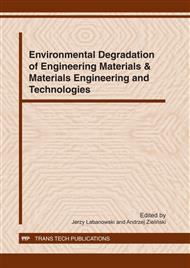[1]
A. Zieliński, S. Sobieszczyk, T. Seramak et al.: Biocompatibility and bioactivity of load-bearing metallic implants, Adv. Mater. Sci. 10, No. 4 (2010) 21-31.
DOI: 10.2478/v10077-010-0013-1
Google Scholar
[2]
S. Mridha, T.N. Baker: Metal matrix composite layer formation with 3 μm SiCp powder on IMI318 titanium alloy surfaces through laser treatment, J. Mater. Process. Technol. 63 (1997) 432- 437.
DOI: 10.1016/s0924-0136(96)02660-x
Google Scholar
[3]
M. Katto, M. Nakamura, T. Tanaka, T. Nakayama: Hydroxyapatite coatings deposited by laser-assisted laser ablation method, Appl. Surf. Sci. 197–198 (2002) 768-771.
DOI: 10.1016/s0169-4332(02)00411-7
Google Scholar
[4]
V. Nelea, C. Ristoscu, C. Chiritescu, et al.: Pulsed laser deposition of hydroxyapatite thin films on Ti-5Al-2. 5Fe substrates with and without buffer layers, Appl. Surf. Sci. 168 (2000) 127-131.
DOI: 10.1016/s0169-4332(00)00616-4
Google Scholar
[5]
Y.S. Tian, Q.Y. Zhang, D.Y. Wang, Study on the microstructures and properties of the boride layers laser fabricated on Ti–6Al–4V alloy, J. Mater. Proc. Tech. 209 (2009) 2887-2891.
DOI: 10.1016/j.jmatprotec.2008.06.043
Google Scholar
[6]
A. Courant, J.J. Hantzpergue, S. Benayoun: Surface treatment of titanium by laser irradiation to improve resistance to dry-sliding friction, Wear 236 (1999) 39-46.
DOI: 10.1016/s0043-1648(99)00254-9
Google Scholar
[7]
S. Mridha, T.N. Baker: Crack-free hard surfaces produced by laser nitriding of commercial purity titanium, Mater. Sci. Eng. A 188 (1994) 229-239.
DOI: 10.1016/0921-5093(94)90376-x
Google Scholar
[8]
C. Hu, T.N. Baker: The importance of preheat before laser nitriding a Ti–6Al–4V alloy, Mater. Sci. Eng. A 265 (1999) 268-275.
DOI: 10.1016/s0921-5093(98)01135-6
Google Scholar
[9]
N. Ohtsu, K. Kodama. K. Kitagawa. K. Wagatsuma: Comparison of surface films formed on titanium by pulsed Nd: YAG laser irradiation at different powers and wavelengths in nitrogen atmosphere, Appl. Surf. Sci. 256 (2010) 4522-4526.
DOI: 10.1016/j.apsusc.2010.02.040
Google Scholar
[10]
N. Ohtsu. M. Yamane. K. Kodama. K. Wagatsuma: Surface hardening of titanium by pulsed Nd: YAG laser irradiation at 1064- and 532-nm wavelengths in nitrogen atmosphere, Appl. Surf. Sci. 257 (2010) 691-695.
DOI: 10.1016/j.apsusc.2010.07.025
Google Scholar
[11]
E.C. Santos. M. Morita, M. Shiomi et al.: Laser gas nitriding of pure titanium using CW and pulsed Nd: YAG lasers, Surf. Coat. Techn. 201 (2006) 1635-1642.
DOI: 10.1016/j.surfcoat.2006.02.048
Google Scholar
[12]
S. Sathish, M. Geetha, N.D. Pandey et al.: Studies on the corrosion and wear behavior of the laser nitrided biomedical titanium and its alloys, Mater. Sci. Eng. C 30 (2010) 376-382.
DOI: 10.1016/j.msec.2009.12.004
Google Scholar
[13]
M. Gołębiewski, G. Krużel, R. Major et al.: Morphology of titanium nitride produced using glow discharge nitriding, laser remelting and pulsed laser deposition, Mater. Chem. Phys. 81 (2003) 315-318.
DOI: 10.1016/s0254-0584(02)00591-6
Google Scholar
[14]
P. Jiang, X.L. He, P. He et al.: Wear resistance of a laser surface alloyed Ti–6Al–4V alloy, Surf. Coat. Techn. 130 (2000) 24-28.
DOI: 10.1016/s0257-8972(00)00680-0
Google Scholar
[15]
D.S. Badkar, K.S. Pandey, G. Buvanashekar, Parameter optimization of laser transformation hardening by using Taguchi method and utility concept, Intl. J. Adv. Manufact. Techn. 52 (2011) 1067-1077.
DOI: 10.1007/s00170-010-2787-z
Google Scholar
[16]
A. Watanabe, M.M. McBride, P. Newton, K.S. Kurtz: Laser surface treatment to improve mechanical properties of cast titanium, Dental Mater. 25 (2009) 629-633.
DOI: 10.1016/j.dental.2008.11.006
Google Scholar
[17]
Robinson J.M., Reed R.C., Van Brussel B.A., De Hosson J.T.M.: X-ray measurement of residual stresses in laser surface melted Ti-6Al-4V alloy, Mater. Sci. Eng. A 208 (1996) 143-151.
DOI: 10.1016/0921-5093(95)10158-6
Google Scholar
[18]
M. Trtica, B. Gakovic, D. Batani et al.: Surface modifications of a titanium implant by a picosecond Nd: YAG laser operating at 1064 and 532 nm, Appl. Surf. Sci. 253 (2006) 2552-2556.
DOI: 10.1016/j.apsusc.2006.05.024
Google Scholar
[19]
Z. Sun, I. Annergren, D. Pan, T.A. Mai: Effect of laser surface remelting on the corrosion behavior of commercially pure titanium sheet, Mater. Sci. Eng. A 345 (2003) 293-300.
DOI: 10.1016/s0921-5093(02)00477-x
Google Scholar
[20]
M. Bereznai, I. Pelsöczi, Z. Tóth et al.: Surface modifications induced by ns and sub-ps excimer laser pulses on titanium implant material, Biomaterials 24 (2003) 4197-4203.
DOI: 10.1016/s0142-9612(03)00318-1
Google Scholar
[21]
T.M. Yue, T.M. Cheung, H.C. Man: The effects of laser surface treatment on the corrosion properties of Ti-6Al-4V alloy in Hank`s solution, J. Mater. Sci. Lett. 19 (2000) 205-208.
Google Scholar
[22]
T.M. Yue, J.K. Yu, Z. Mei, H.C. Man: Excimer laser surface treatment of Ti-6Al-4V alloy for corrosion resistance enhancement, Mater. Lett. 52 (2002) 206-212.
DOI: 10.1016/s0167-577x(01)00395-0
Google Scholar
[23]
F. Guillemot, E. Prima et al.: Ultraviolet laser surface treatment fore biomedical applications of b titanium alloys: morphological and structural characterization, Appl. Phys. A 77 (2003) 899-904.
DOI: 10.1007/s00339-003-2162-0
Google Scholar
[24]
C. -Y. Park, S. -G. Kim, M. -D. Kim et al.: Dental implant. Surface properties of endosseous dental implants after NdYAG and CO2 laser treatment at various energies, J. Oral Maxillofac. Surg. 63 (2005) 1522-1527.
DOI: 10.1016/j.joms.2005.06.015
Google Scholar
[25]
A.Y. Vorobyev, C. Guo: Femtosecond laser structuring of titanium implants, Appl. Surf. Sci. 253 (2007) 7272-7280.
DOI: 10.1016/j.apsusc.2007.03.006
Google Scholar
[26]
Y. Lin, M.C. Gupta, R.E. Taylor et al. : Nanosecond pulsed laser micromachining for experimental fatigue life study of Ti–3Al–2. 5V tubes, Optics Lasers Eng. 47 (2009) 118-122.
DOI: 10.1016/j.optlaseng.2008.07.008
Google Scholar
[27]
A. Charles S. Montross, T. Wei, L. Ye et al.: Laser shock processing and its effects on microstructure and properties of metal alloys: a review, Int. J. Fatigue 24 (2002) 1021-1036.
DOI: 10.1016/s0142-1123(02)00022-1
Google Scholar
[28]
B. Majkowska, W. Serbiński: Cavitation wearing of the SUPERSTON alloy after laser treatment at cryogenic conditions, Solid State Phenom. 165 (2010) 306-309.
DOI: 10.4028/www.scientific.net/ssp.165.306
Google Scholar
[29]
A. Zieliński, W. Serbiński, B. Majkowska, M. Jażdżewska, I. Skalski: Influence of laser remelting at cryogenic conditions on corrosion resistance of non-ferrous alloys, Adv. Mater. Sci. 9, No. 4 (2009) 21-28.
DOI: 10.2478/v10077-009-0018-9
Google Scholar
[30]
Y.S. Tian, C.Z. Chen, S.T. Li, Q.H. Huo: Research progress on laser surface modification of titanium alloys, Appl. Surf. Sci. 242 (2005) 177-184.
DOI: 10.1016/j.apsusc.2004.08.011
Google Scholar


